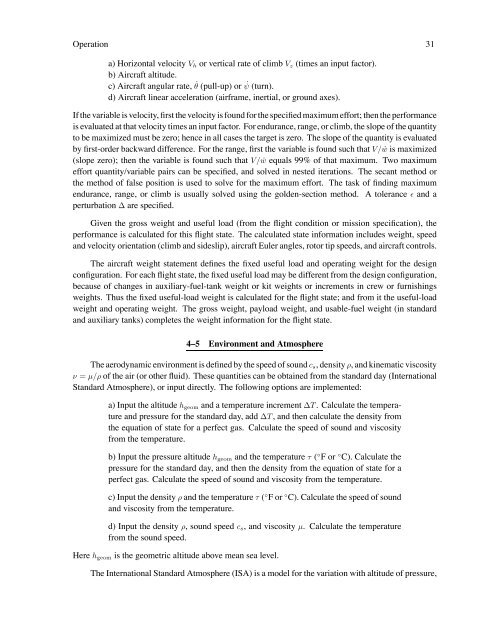Download - NASA
Download - NASA
Download - NASA
You also want an ePaper? Increase the reach of your titles
YUMPU automatically turns print PDFs into web optimized ePapers that Google loves.
Operation 31<br />
a) Horizontal velocity Vh or vertical rate of climb Vz (times an input factor).<br />
b) Aircraft altitude.<br />
c) Aircraft angular rate, ˙ θ (pull-up) or ˙ ψ (turn).<br />
d) Aircraft linear acceleration (airframe, inertial, or ground axes).<br />
If the variable is velocity, first the velocity is found for the specified maximum effort; then the performance<br />
is evaluated at that velocity times an input factor. For endurance, range, or climb, the slope of the quantity<br />
to be maximized must be zero; hence in all cases the target is zero. The slope of the quantity is evaluated<br />
by first-order backward difference. For the range, first the variable is found such that V/ ˙w is maximized<br />
(slope zero); then the variable is found such that V/ ˙w equals 99% of that maximum. Two maximum<br />
effort quantity/variable pairs can be specified, and solved in nested iterations. The secant method or<br />
the method of false position is used to solve for the maximum effort. The task of finding maximum<br />
endurance, range, or climb is usually solved using the golden-section method. A tolerance ɛ and a<br />
perturbation Δ are specified.<br />
Given the gross weight and useful load (from the flight condition or mission specification), the<br />
performance is calculated for this flight state. The calculated state information includes weight, speed<br />
and velocity orientation (climb and sideslip), aircraft Euler angles, rotor tip speeds, and aircraft controls.<br />
The aircraft weight statement defines the fixed useful load and operating weight for the design<br />
configuration. For each flight state, the fixed useful load may be different from the design configuration,<br />
because of changes in auxiliary-fuel-tank weight or kit weights or increments in crew or furnishings<br />
weights. Thus the fixed useful-load weight is calculated for the flight state; and from it the useful-load<br />
weight and operating weight. The gross weight, payload weight, and usable-fuel weight (in standard<br />
and auxiliary tanks) completes the weight information for the flight state.<br />
4–5 Environment and Atmosphere<br />
The aerodynamic environment is defined by the speed of sound cs, density ρ, and kinematic viscosity<br />
ν = μ/ρ of the air (or other fluid). These quantities can be obtained from the standard day (International<br />
Standard Atmosphere), or input directly. The following options are implemented:<br />
a) Input the altitude hgeom and a temperature increment ΔT . Calculate the temperature<br />
and pressure for the standard day, add ΔT , and then calculate the density from<br />
the equation of state for a perfect gas. Calculate the speed of sound and viscosity<br />
from the temperature.<br />
b) Input the pressure altitude hgeom and the temperature τ ( ◦ For ◦ C). Calculate the<br />
pressure for the standard day, and then the density from the equation of state for a<br />
perfect gas. Calculate the speed of sound and viscosity from the temperature.<br />
c) Input the density ρ and the temperature τ ( ◦ For ◦ C). Calculate the speed of sound<br />
and viscosity from the temperature.<br />
d) Input the density ρ, sound speed cs, and viscosity μ. Calculate the temperature<br />
from the sound speed.<br />
Here hgeom is the geometric altitude above mean sea level.<br />
The International Standard Atmosphere (ISA) is a model for the variation with altitude of pressure,
















